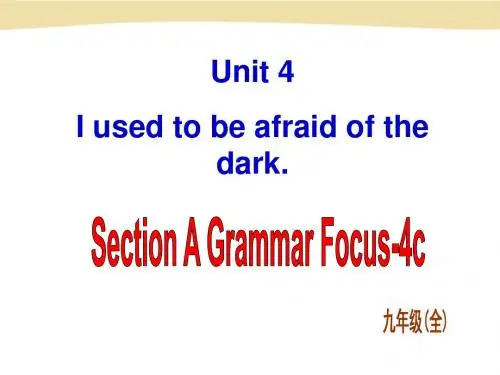2019精品教育Unit4第四课时
- 格式:doc
- 大小:60.52 KB
- 文档页数:6
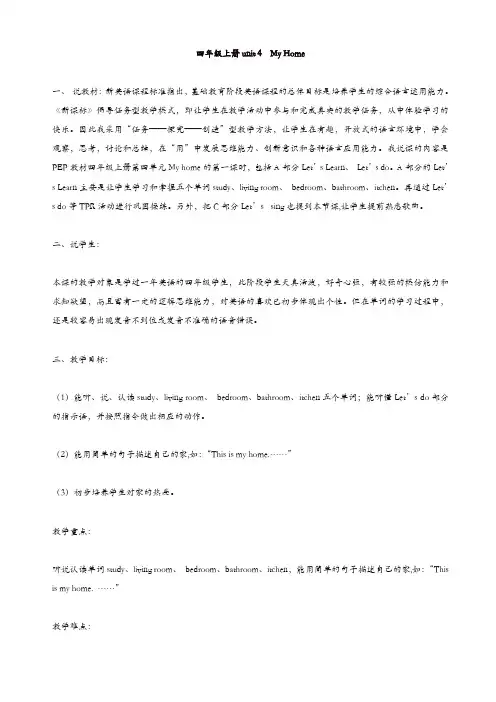
四年级上册unit 4 My Home一、说教材:新英语课程标准指出,基础教育阶段英语课程的总体目标是培养学生的综合语言运用能力。
《新课标》倡导任务型教学模式,即让学生在教学活动中参与和完成真实的教学任务,从中体验学习的快乐。
因此我采用“任务——探究——创造”型教学方法,让学生在有趣,开放式的语言环境中,学会观察,思考,讨论和总结,在“用”中发展思维能力、创新意识和各种语言应用能力。
我说课的内容是PEP教材四年级上册第四单元My home的第一课时,包括A部分Let’s Learn、Let’s do。
A部分的Let’s Learn主要是让学生学习和掌握五个单词study、living room、bedroom、bathroom、itchen。
再通过Let’s do等TPR活动进行巩固操练。
另外,把C部分Let’s sing也提到本节课,让学生提前熟悉歌曲。
二、说学生:本课的教学对象是学过一年英语的四年级学生,此阶段学生天真活泼,好奇心强,有较强的模仿能力和求知欲望,而且富有一定的逻辑思维能力,对英语的喜欢已初步体现出个性。
但在单词的学习过程中,还是较容易出现发音不到位或发音不准确的语音错误。
三、教学目标:(1)能听、说、认读study、living room、bedroom、bathroom、itchen五个单词;能听懂Let’s do部分的指示语,并按照指令做出相应的动作。
(2)能用简单的句子描述自己的家,如:“This is my home.……”(3)初步培养学生对家的热爱。
教学重点:听说认读单词study、living room、bedroom、bathroom、itchen,能用简单的句子描述自己的家,如:“This is my home. ……”教学难点:正确掌握单词bedroom、itchen、bathroom的发音。
四、教学方法设计:1、教具、学具的准备精美、直观、实用的教具,能有效吸引学生的目光,激发学生学习的兴趣。
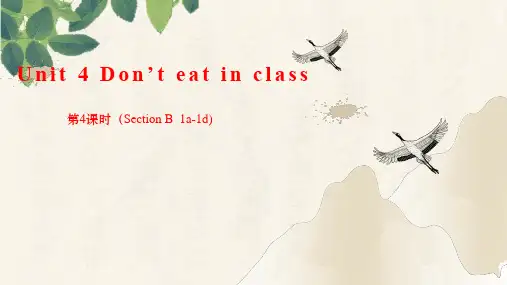
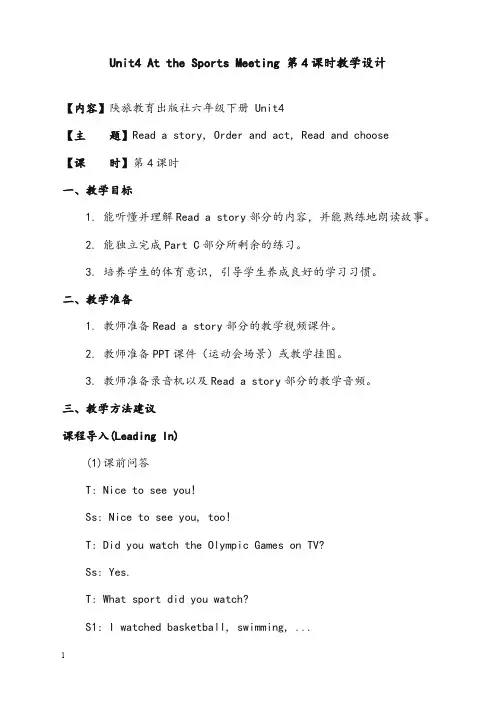
Unit4 At the Sports Meeting 第4课时教学设计【内容】陕旅教育出版社六年级下册 Unit4【主题】Read a story, Order and act, Read and choose【课时】第4课时一、教学目标1. 能听懂并理解Read a story部分的内容,并能熟练地朗读故事。
2. 能独立完成Part C部分所剩余的练习。
3. 培养学生的体育意识,引导学生养成良好的学习习惯。
二、教学准备1. 教师准备Read a story部分的教学视频课件。
2. 教师准备PPT课件(运动会场景)或教学挂图。
3. 教师准备录音机以及Read a story部分的教学音频。
三、教学方法建议课程导入(Leading In)(1)课前问答T: Nice to see you!Ss: Nice to see you, too!T: Did you watch the Olympic Games on TV?Ss: Yes.T: What sport did you watch?S1: I watched basketball, swimming, ...S2: I watched ...(2)新课导入1. 教师借助PPT展示sports meeting的图画,让学生看图描述运动场上的场景。
教师可以这样引导:What can you see from the picture?What kind of sports do the pupils take part in?Look at the players. What are they doing now?Look at the other pupils. How are they feeling?随机选取学生描述运动会场景,教师在必要时可引导学生尽可能多地运用已学过的功能结构进行完整的表达。
对描述熟练,语言丰富的学生给予表扬,并对需要帮助的学生给予积极的指导鼓励,树立其信心。
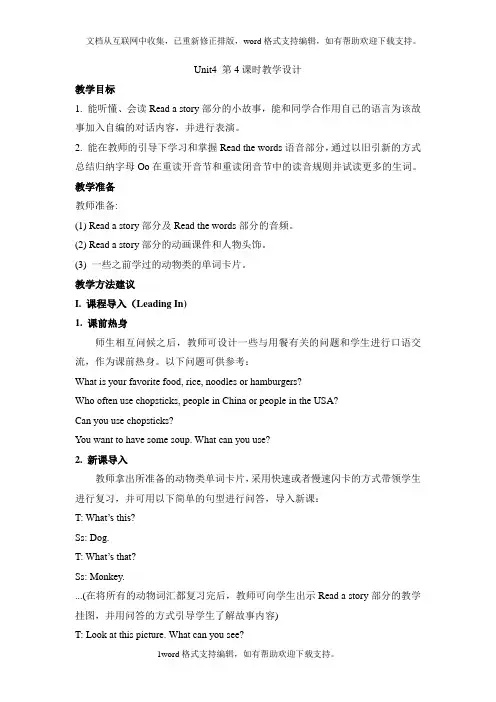
Unit4 第4课时教学设计教学目标1. 能听懂、会读Read a story部分的小故事,能和同学合作用自己的语言为该故事加入自编的对话内容,并进行表演。
2. 能在教师的引导下学习和掌握Read the words语音部分,通过以旧引新的方式总结归纳字母Oo在重读开音节和重读闭音节中的读音规则并试读更多的生词。
教学准备教师准备:(1) Read a story部分及Read the words部分的音频。
(2) Read a story部分的动画课件和人物头饰。
(3) 一些之前学过的动物类的单词卡片。
教学方法建议I. 课程导入(Leading In)1. 课前热身师生相互问候之后,教师可设计一些与用餐有关的问题和学生进行口语交流,作为课前热身。
以下问题可供参考:What is your favorite food, rice, noodles or hamburgers?Who often use chopsticks, people in China or people in the USA?Can you use chopsticks?You want to have some soup. What can you use?2. 新课导入教师拿出所准备的动物类单词卡片,采用快速或者慢速闪卡的方式带领学生进行复习,并可用以下简单的句型进行问答,导入新课:T: What’s this?Ss: Dog.T: What’s that?Ss: Monkey....(在将所有的动物词汇都复习完后,教师可向学生出示Read a story部分的教学挂图,并用问答的方式引导学生了解故事内容)T: Look at this picture. What can you see?Ss: I can see a tiger, a fox, a pig and a monkey.T: Great! You’ve done a good job. Look! The animals are at table. What are they doing?Ss: They are eating.T: Good! They are having dinner happily. Let’s watch the short video.II. 课程展示活动和过程的设计建议(Presentation)1. Part B Read a story(1) 教师播放Read a story部分的动画视频,学生集体观看视频。
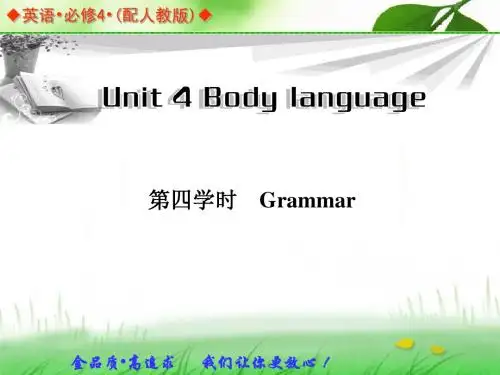
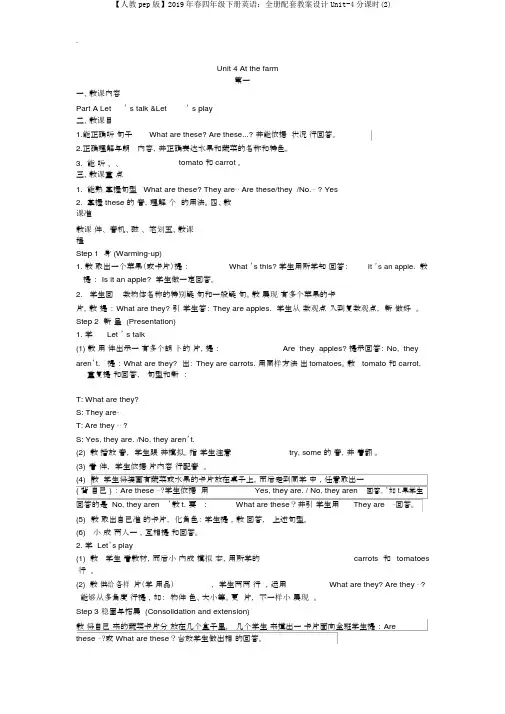
Unit 4 At the farm第一一、教课内容Part A Let’ s talk &Let’ s play二、教课目1.能正确听句子What are these? Are these...? 并能依据状况行回答。
2.正确理解与朗内容,并正确表达水果和蔬菜的名称和特色。
3.能听、、tomato 和 carrot 。
三、教课重点1.能熟掌握句型 What are these? They are⋯Are these/they /No.⋯? Yes2.掌握 these 的音,理解个的用法。
四、教课准教课件、音机、磁、笔划五、教课程Step 1 身 (Warming-up)1. 教取出一个苹果(或卡片)提:What ’s this? 学生用所学知回答:It ’s an apple. 教提: Is it an apple? 学生做一定回答。
2.学生回数物体名称的特别疑句和一般疑句。
教展现有多个苹果的卡片,教提: What are they? 引学生答: They are apples. 学生从数观点入到复数观点,新做好。
Step 2 1. 学新呈 (Presentation) Let ’ s talk(1) 教用件出示一有多个胡卜的片,提:Are they apples? 提示回答: No, theyaren’t. 提: What are they? 出: They are carrots. 用同样方法出tomatoes。
教 tomato 和 carrot, 重复提和回答,句型和新:T: What are they?S: They are⋯T: Are they ⋯ ?S: Yes, they are. /No, they aren’t.(2) 教播放音,学生跟并模拟。
指学生注意try, some 的音,并着翻。
(3)看件,学生依据片内容行配音。
(4)教学生将装画有蔬菜或水果的卡片放在桌子上,而后走到同学中,任意取出一( 背自己 ): Are these ⋯?学生依据用Yes, they are. / No, they aren回答。
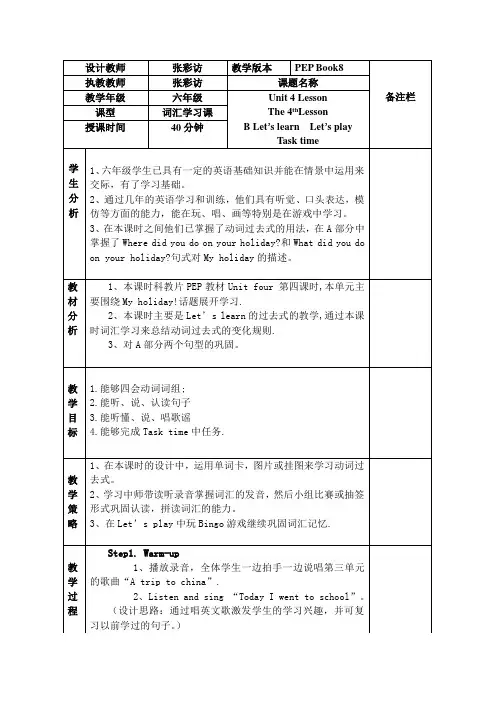
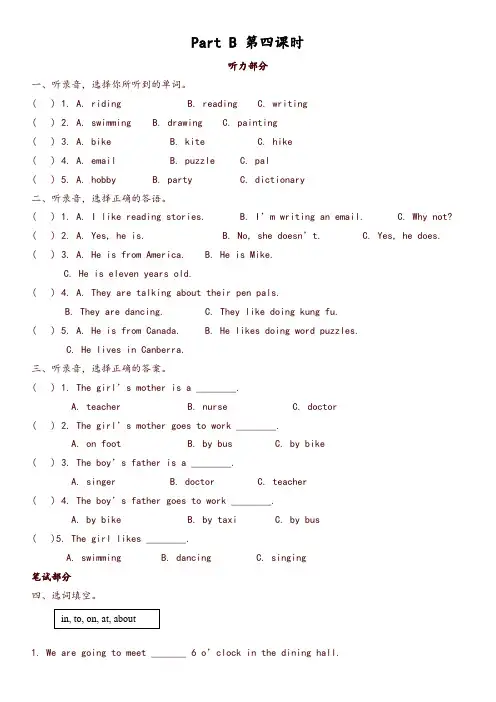
Part B 第四课时听力部分一、听录音,选择你所听到的单词。
( ) 1. A. ridingB. readingC. writing ( ) 2. A. swimmingB. drawingC. painting ( ) 3. A. bikeB. kiteC. hike ( ) 4. A. emailB. puzzleC. pal ( ) 5. A. hobby B. partyC. dictionary 二、听录音,选择正确的答语。
( ) 1. A. I like reading stories.B. I ’m writing an email.C. Why not? ( ) 2. A. Yes, he is. B. No, she doesn’t .C. Yes, he does. ( ) 3. A. He is from America.B. He is Mike.C. He is eleven years old. ( ) 4. A. They are talking about their pen pals.B. They are dancing.C. They like doing kung fu.( ) 5. A. He is from Canada.B. He likes doing word puzzles.C. He lives in Canberra.三、听录音,选择正确的答案。
( ) 1. The girl ’s mother is a ________.A. teacherB. nurseC. doctor( ) 2. The girl ’s mother goes to work ________.A. on footB. by busC. by bike( ) 3. The boy ’s father is a ________.A. singerB. doctorC. teacher( ) 4. The boy ’s father goes to work ________.A. by bikeB. by taxiC. by bus( )5. The girl likes ________.A. swimmingB. dancingC. singing笔试部分四、选词填空。
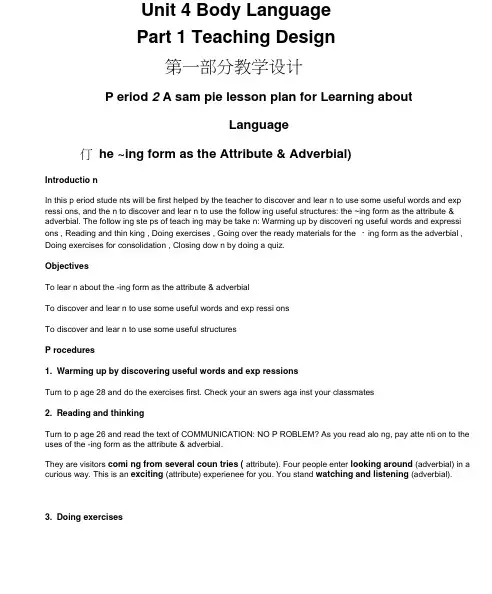
Unit 4 Body LanguagePart 1 Teaching Design第一部分教学设计P eriod 2 A sam pie lesson plan for Learning aboutLanguage仃he ~ing form as the Attribute & Adverbial)Introductio nIn this p eriod stude nts will be first helped by the teacher to discover and lear n to use some useful words and exp ressi ons, and the n to discover and lear n to use the follow ing useful structures: the ~ing form as the attribute & adverbial. The follow ing ste ps of teach ing may be take n: Warming up by discoveri ng useful words and expressi ons , Reading and thin king , Doing exercises , Going over the ready materials for the ・ing form as the adverbial , Doing exercises for consolidation , Closing dow n by doing a quiz.ObjectivesTo lear n about the -ing form as the attribute & adverbialTo discover and lear n to use some useful words and exp ressi onsTo discover and lear n to use some useful structuresP rocedures1. Warming up by discovering useful words and exp ressionsTurn to p age 28 and do the exercises first. Check your an swers aga inst your classmates2. Reading and thinkingTurn to p age 26 and read the text of COMMUNICATION: NO P ROBLEM? As you read alo ng, pay atte nti on to the uses of the -ing form as the attribute & adverbial.They are visitors comi ng from several coun tries ( attribute). Four people enter looking around (adverbial) in a curious way. This is an exciting (attribute) experienee for you. You stand watching and listening (adverbial).3. Doing exercisesTurn to p age 29. Do the exercises.4. Studying the -ing form as the adverbialthe ・ng form as the adverbialthe -ing form作状语表示主语在进行一动作的同时所进行的另一动作,它对谓语动词起修饰或陪衬的作用。
![[精品]2019九年级英语全册 Unit 4 The fourth period、The fifth period教案 (新版)人教新目标版](https://uimg.taocdn.com/9c433937b7360b4c2e3f64da.webp)
Unit 4 I used to be afraid of the dark.The fourth periodⅠ. Teaching Aims and Demands1. Knowledge Objects(1) Key Vocabularyspider, insect, chew, gum(2) Target LanguageI used to eat candy all the time. Did you?Yes, I did. And I used to chew gum a lot.2. Ability ObjectTrain students’ ability to talk about what they used to be/do.3. Moral ObjectPeople surely change. Students should take good care of the process of their growth.Ⅱ. Teaching Key Points1. Key Vocabularyspider, insect, chew, gum2. Target LanguageI used to eat candy all the time. Did you?Yes, I did. And I used to chew gum a lot.Ⅲ. Teaching Difficult PointTalk about what you used to be/do.Ⅳ. Teaching MethodPractice methodⅤ. Teaching Aids1. A tape recorder2. A picture with spiders and a picture with insects.3. A gumⅥ. Teaching ProceduresStep 1 RevisionCheck homework. Invite different students to report what his/her grandparents, parents, aunts, uncles, or old friends used to be afraid of when they were young.Step2 1aThis activity introduces new vocabulary words and provides practice with the target language.Using pictures, teach students to practice the words spider and insect. Teach theword gum by holding up a gum. And teach the verb chew by chewing the gum.Ask students to complete the work individually.Check the answers by inviting different students to report his/her work like this:When I was a child, I used to like painting pictures and singing in music class.Say each number to the class and ask students to raise their hands for each thing they used to like to do. Then discuss the results with the class.Step 31bThis activity provides practice with the target language.Point out the box under the pictures.Read the instructions to the class. Say,You are to write some other things that you used to like to do when you were a children on the lines in the box. Remind students to write sentences.As students work, move around the room offering language support and helping them with any words they want to use.Get a student to write his/her sentences on the blackboard. Help correct any errors.Sample answers1. I used to play football with my brother.2. I used to eat hamburgers a lot.3. I used to watch cartoons.4. I used to run with my father in the morning.Step 4 2a 2bThis activity provides listening practice using the target language.Set a time limit of one minute. Ask students to look through the sentences in the box.Say, You will hear a boy and a girl talking about how life used to be when they were much younger onthe recording. Listen and check the sentences you hear.Point out the sample answer. Play the recording for the first time. Students only listen.Play the recording again. This time students check the sentences they hear.Check the answers.AnswersChecked sentences: 1,2,3TapescriptGirl 1: My six-year-old brother started school this week.Boy 1: He’s really lucky. Life was great when I was six.Girl 1: Really? Why?Boy 1: Oh, schoolwork was really easy.Girl 1: Not for me. I didn’t use to like tests. Now I don’t worry about tests.Boy 1: And we used to play every day after school. Now we just study all the time.Girl 1: Yeah, but we used to walk to school. Now we have to take the bus.Boy 1: I remember one thing. I used to hate gym. Now I love gym class.Girl 1: Me, too.Step 5 2cThis activity provides oral practice using the target language.Ask a pair of students to read the sample conversation to the class.Optional activityAsk students to talk about good and bad habits. Then make sentences with “used to”to show which habitsthey have stopped and make sentences with “still” to show which ones they still have.Step 6 Summary and HomeworkSay, In this class, we’ve learned the new vocabulary words spider, insect, gum and chew and the target language I used to do sth. After class, finish writing the sentences in Optional Activity.The fifth periodStep 1 Fill in each blank with correct words givenStep 2 Use phrase “used to ” to write about Yu MeiStep 3 ReadingMartin Murray is a fifteen-year-old boy. He used to be a “problem child”,(1) . He didn’t use to give his mother many problems.However, after his father’s death a few years ago, Martin’s life became much more difficult.His mother couldn’t afford to pay for her child’s education. To do this, she had to work, and so was not often at home. His mother looked after him as well as she could. Unfortunately, Martin still cause d problems for himself and his family. He was not interested in studying, and he often got into trouble with the police. Luckily, his mother was very patient,(2) . In the end, she made a difficult decision: to send him to aboy’s boarding school. Martin hated it and used to cause a lot of trouble. One day, he told his teacher he wanted to leave the school. (3) . The head teacher said it was necessary to talk with his mother. Martin called his mother, but to his surprise, this phone call changed his life. “It was exactly what I needed,” he said. “My mother helped me to understand how much she had given me. She also told me that even though my father was no longer with us, he was watching me, and would always take pride in everything good I do.(4) . I realize that since my father died, I have been afraidof being alone, and have tried to make my mother pay more attention to me.”Now Martin has really changed. He has been working hard, and he is now a top student in his class.(5) . His mother’s love helped him to feel good about himself, and as Martinhimself says, “It’s very important for parents to be there for their children.”Step 4 Homework。
